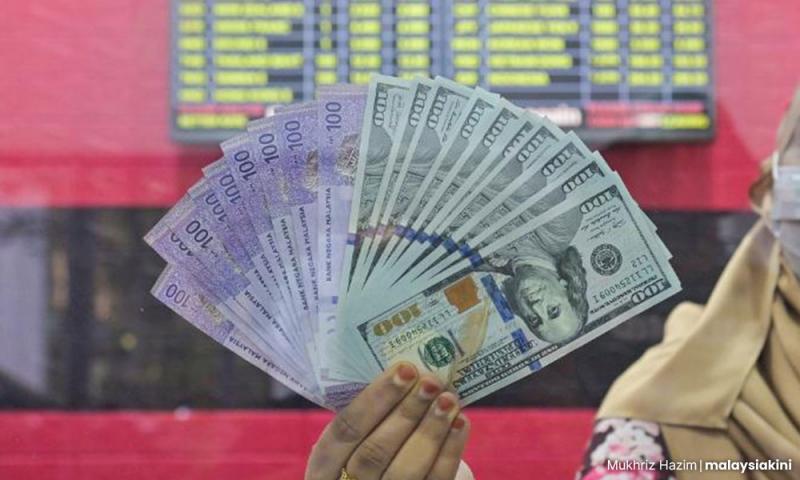LETTER | Understanding ramifications of declining ringgit
LETTER | The persistent decline of the ringgit brings it perilously close to reaching a historic low, with the combined factors of Malaysia's weakening exports and the strength of the US dollar potentially propelling the currency beyond that threshold.
The ringgit has depreciated by almost four percent since the beginning of the year. There exists a possibility that the ringgit could plummet to a record low of RM5 to US$1, fueled by the sluggish recovery of exports compared to other Asian economies and the likelihood of lacklustre economic growth.
The local currency briefly slipped past 4.800 against the dollar recently, the weakest level since January 1998, at the height of the crisis that rattled the Asian financial markets.
Sputtering growth in China, Malaysia’s biggest trading partner, has weighed on the export-reliant economy. Economists have lowered their forecasts for 2024 gross domestic product (GDP) growth to 4.3 percent from 4.5 percent after last year’s expansion missed estimates.
Malaysia’s wide interest rate gap with the US also dimmed the allure of its assets, while there are lingering concerns over political stability.
In a nutshell, the ringgit emerged as Asia’s worst performer last year.

Despite the 8.7 percent year-on-year growth in January, Malaysia's export sector has experienced a prolonged period of contraction, lasting for 10 consecutive months prior to this uptick.
While this recent expansion is a positive sign, the sustained weakness in exports underscores the challenges faced by the Malaysian economy and the need for sustained efforts to diversify and strengthen its export base.
While a depreciating currency can benefit a nation's exports and tourism industry by making their goods and services more competitively priced on the global market, enticing more foreign visitors and investors due to favourable exchange rates, it presents challenges for local businesses that rely on imported materials for their operations.
As the ringgit’s value decreases, the cost of importing these materials rises, thus squeezing profit margins for these businesses.
Companies that have taken on debt denominated in US dollars may face increased repayment burdens as the ringgit weakens. This could potentially strain their financial health and hinder their ability to invest in growth or meet other financial obligations.
A weaker currency often translates to higher import costs, particularly for essential commodities like oil, machinery and electronics. This could stoke inflationary pressures, impacting consumers' purchasing power and necessitating prudent monetary policies to maintain price stability.
Further to this, Malaysia's external debt, denominated in foreign currencies, could become more burdensome to repay if the ringgit weakens further against major currencies. This could strain the country's finances and lead to increased borrowing costs.
Some measures to be considered
In response to currency fluctuations, the government and central bank would likely deploy a mix of fiscal and monetary measures to stabilise the ringgit and mitigate economic imbalances.
These could include interest rate adjustments such as the overnight policy rate (OPR), foreign exchange market interventions and targeted fiscal stimulus to support key sectors.
As inflationary pressures mount, the burden could disproportionately fall on lower-income households, exacerbating income inequality and widening socioeconomic divide.
Policymakers would need to ensure that social safety nets are robust enough to cushion the impact on vulnerable segments of society.
The perception of economic stability and government competence plays a crucial role in shaping public confidence. A sharp depreciation of the ringgit could erode trust in the government's ability to manage the economy effectively, potentially leading to social unrest or political discontent.
Long-term resilience against currency volatility necessitates structural reforms aimed at diversifying the economy, enhancing productivity and reducing reliance on exports.
Investments in education, technology and innovation could lay the groundwork for sustainable economic growth and resilience in the face of external shocks.

While a temporary weakening of the ringgit may offer short-term advantages such as export competitiveness and increased tourism revenue, sustained depreciation could pose challenges to Malaysia's economic stability and long-term prosperity.
Structural imbalances, such as over-reliance on exports or excessive foreign currency debt, could undermine resilience and hamper sustainable growth.
The hypothetical scenario of Malaysia reaching RM5 to US$1 underscores the intricate interplay between currency dynamics, economic fundamentals and socio-political considerations.
As Malaysia navigates these economic waters, policymakers must strike a delicate balance between short-term imperatives and long-term sustainability.
By implementing prudent policies, fostering inclusive growth and embracing structural reforms, Malaysia can chart a course towards economic resilience and prosperity in an ever-changing global landscape.
Writers are lecturers for the School of Accounting and Finance, Taylor’s University.
The views expressed here are those of the author/contributor and do not necessarily represent the views of Malaysiakini.
RM12.50 / month
- Unlimited access to award-winning journalism
- Comment and share your opinions on all our articles
- Gift interesting stories to your friends
- Tax deductable
